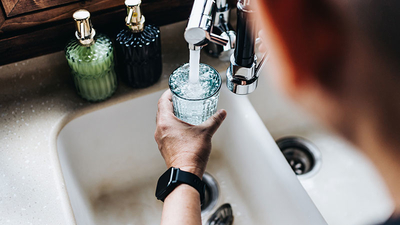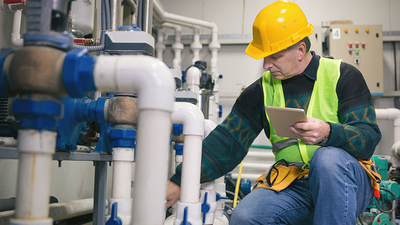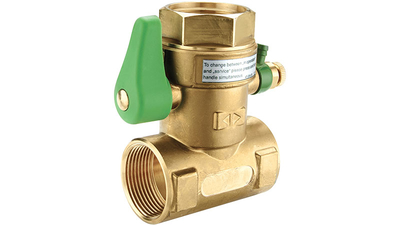What are anti-legionella valves and why and how should you install them?

Whilst installing efficient and aesthetically pleasing plumbing systems is an extremely important aspect of an installer’s job, above all else, plumbing systems need to be safe. Whether it be scalding or burst pipes, there are many ways that plumbing systems can cause health and safety issues.
Sharing the top spot alongside scalding, Legionnaires disease is one of these potential concerns, and one that can cause serious harm. Therefore, it is imperative that installers make use of the right valves, pipes, and fittings to ensure the plumbing system they install is safe and fit for purpose.
With changes to Part L of the Building Regulations meaning that installers are going to have to actively take more steps to prevent Legionella bacteria from forming in heating systems, we are here to re-stress the importance of anti-legionella valves and the best practice to install them.
What changes have been made?
Among many other revisions made to Part L of the Building Regulations, one such change that has many people scratching their heads is an update on allowed flow temperatures in heating systems. The flow temperature of heating systems can no longer exceed 55°C and, in fact, they should be below this temperature if possible.
Whilst there are valid reasons for introducing such a change, what the change perhaps overlooks, is how it will affect the frequency at which Legionella bacteria forms in heating systems. The bacteria grows in stagnant water ranging from 20°C-45°C, but can survive in temperatures up to 60°C. Hence why this change on allowed temperatures is so impactful.
Legionella bacteria, when inhaled into the lungs can cause Legionnaires disease, which is a serious type of lung infection you can get from inhaling droplets of water containing the bacteria. The disease is a type of atypical pneumonia, which, whilst uncommon, can be very serious.
Poorly designed plumbing or heating systems are much more likely to harbour Legionella bacteria. This is especially true of plumbing systems with ‘dead legs’ in the system, which is an area isolated from the regular flow of water where stagnant water collects. This is why Legionella bacteria is not a risk in underfloor heating systems. Because, even though the system sits at 38°C, the water is constantly moving. However, the bacteria can form in cooling towers, humidifiers, hot water systems, room-air humidifiers and central air condition systems.

So, how do we prevent Legionnaires disease through plumbing?
Without being facetious, keeping all systems below 20°C or above 60°C would technically work in preventing the build-up of Legionella bacteria. However, not only do these regulation changes stop you from doing so, the amount of infrastructure that would require is unrealistic.
Instead, the Control of Substance Hazardous to Health Regulations 2002 (COSHH) offers a framework to assess, prevent, and control the risk from bacteria like Legionella and suggests suitable precautions.
The first step is to install WRAS-approved anti-legionella valves, which are designed to keep water flowing through a typical single connection to an expansion vessel.
What are anti-legionella valves?
As the name suggests anti legionella valves are purpose built to prevent Legionella bacteria from propagating in plumbing and heating systems. They achieve this by keeping the water flowing through a standard single connection to an expansion vessel. This works by redirecting a part of the flow into the vessel and regularly replacing the water within.
The valves are an alternative to installing a flow-through expansion vessel, which can be bulky and can cause logistical problem in retrofit projects. It is therefore better, to use only WRAS approved anti-legionella valves and carry out a service on them every year.

Where and how should you install an anti-legionella valve?
When it comes to best-practice installation, the process is very straightforward. In fact, all you need is a spanner, a Reliance Valves Aquasystem potable water expansion vessel with a 3/4" connection, and of course the anti-legionella valve.
The WRAS-certified anti-legionella valve from Reliance Valves has an inbuilt isolating valve and rotating tee-piece that make installation quick, simple, and adaptable. Any common vessel with a 3/4" connection or up to 11/4" connectors can utilise them.
Before installing the valve, make sure the plumbing or heating system is flushed of water and free of debris. You also need to check that the system pressure and temperature are within the working parameters of the valve. Once that’s all set up and ready, it’s a simple process to install the valve.
Firstly, the paddle retaining tube should be inserted into the vessel connection by squeezing the tube together and pushing it into the vessel connection before letting the tube spring back into place. Then, the anti-legionella valve should be screwed onto the expansion vessel and tightened with a spanner, being additionally careful to not damage the paddle or the paddle retaining clip. And finally, the 3/4” tee piece should be connected onto the anti-legionella valve and tightened with an appropriately sized spanner. The connection is sealed with an internal O-Ring, which means there’s no need for any extra washers or PTFE tape. The tee piece should remain rotatable through 360° even when it’s tightened.
With all of that in mind you should be fit to comply to the new changes to Part L of the Building Regulations whilst protecting customers from Legionella bacteria. If you have any questions about the anti-legionella valve from Reliance Valves or any other ways you can ensure water safety in your plumbing and heating projects, please contact our team of experts who are happy to support and offer advice.
Discover our range
Reliance Valves Anti-Legionella Valves prevent bacteria from contaminating stored cold water within the expansion vessel by maintaining circulation and eliminating stagnation.
